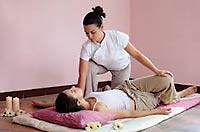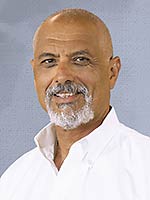|
|
HEALTHY HAPPENING July 2018
|
What Is Thai Massage?
And Why You Might Want To Give It A Try.
by Meagan Coy |
There are many different name variations on the type of bodywork known as Thai massage, such as: “Thai Yoga Massage” or “Thai Healing Massage”. It doesn’t matter what the practitioner wants to call it, all the names generally refer to the same style of traditional Thai massage. This is a modality of bodywork that has started becoming more and more popular in the West and can be found offered by licensed massage therapists in most larger towns and cities through both private practices and spa settings. There is good reason why Thai massage is becoming so popular, as it has proven to show benefits such as; relieving muscle spasms and pain, increasing flexibility and joint mobility, balancing and boosting energy and improving circulation in the body.
If you have ever traveled to Thailand, then you probably noticed Thai massage being offered almost anywhere, and maybe received one (or multiple) as well. Thai massage is considered a branch of Thailand’s traditional medical system and is an integral part of self-care for Thai people in helping relieve ailments and keeping the body and mind healthy and balanced. Historically, Thai massage is believed to have been developed around 2,500 years ago by a man named Jivaka Komarabhacca, who was the Buddha’s physician, and is still honored every day in Thailand by medical practitioners through prayer, chanting, and offerings. The art of Thai massage today has evolved throughout the years from a combination of influences from Indian, Chinese, and Southeastern Asian cultural traditions of medicine. You will find a considerable variation in Thai massage from region to region across Thailand, with no single routine or set framework that is universally accepted among healers. This keeps the possibilities open for the Thai massage therapist to treat each individual according to their needs.
.jpg) What does a typical Thai massage session consist of, you might ask? For starters, there are no oils or lotions used, and the recipient wears comfortable clothing during the entire treatment and lies on a padded mat on the floor. Thai massage employs stretching, pulling, rocking and compression techniques to the body to relieve tension and increase flexibility and range of motion. The therapist will use their hands, knees, legs and feet during a session to put you into a series of intentional and assisted yoga-like stretches combined with rhythmic pressure. Rotation movements are applied to the major joints of the body to keep them supple and healthy. There is also acupressure work involved and is given along designated lines called “sen” in the body, where there are a lot of major muscle attachments, nerves, and energetic blockages held. What does a typical Thai massage session consist of, you might ask? For starters, there are no oils or lotions used, and the recipient wears comfortable clothing during the entire treatment and lies on a padded mat on the floor. Thai massage employs stretching, pulling, rocking and compression techniques to the body to relieve tension and increase flexibility and range of motion. The therapist will use their hands, knees, legs and feet during a session to put you into a series of intentional and assisted yoga-like stretches combined with rhythmic pressure. Rotation movements are applied to the major joints of the body to keep them supple and healthy. There is also acupressure work involved and is given along designated lines called “sen” in the body, where there are a lot of major muscle attachments, nerves, and energetic blockages held.
All these applications combined creates a very holistic treatment for the receiver. The therapist gets to receive benefits as well by breathing intentionally and moving in a very mindful and fluid like way with their whole body during the session. Each Thai massage session can be adjusted and modified for all body types and abilities and can be done on a massage table if the floor isn’t accessible.
Some reasons why someone might want to consider trying Thai massage are: If you are looking for a treatment different from the traditional Swedish or deep tissue table massage, are feeling particularly sore and stiff from exercise or arthritis, are wanting to reduce stress or chronic pain, or are wanting a bodywork treatment that approaches the body from both a spiritual and physical perspective that benefits both the therapist and the receiver. If any of these reasons sound true to you, then Thai massage may just be what you are looking for!
Meagan Coy is a Licensed Massage Therapist and Registered Yoga Teacher and is the owner of M.C.’s Healing Arts in Moab. She has trained and studied both in the U.S. and in Thailand and offers Thai massage, along with other types of modalities at her practice. She also teaches public Yoga classes through the Moab Yoga Studio. You can contact her through www.mcmassagetherapy.com or call: 563-528-2908. And be sure to mention you read about it in the Moab Happenings.
|
Seeing a Urologist 101: Trust Us, it’s important! |
When should you see a urologist?
A urologist can treat all things pertaining to your bladder and urination. Blood in urine, pain during urination, poor bladder control, overactive bladder, and incontinence are all symptoms of concern.
Men in particular need to pay attention to prostate cancer statistics. According to the American Cancer Society, About 1 in 9 men will be diagnosed with prostate cancer in his lifetime. You should see a urologist if you have prostate cancer in your family, if you have an enlarged prostate, or if you have an elevated level of Prostate Specific Antigen (PSA).
In addition, a urologist can also treat erectile dysfunction and other sexual problems.
Urologists also specialize in diseases involving the kidneys and can treat for kidney stones.
What can you expect at an appointment?
The urologist will have notes from your referring primary care provider and will go more in depth about your medical history and do a physical exam. Urologists often order tests such as imaging tests, CT scans, MRI scans, or ultrasounds. All of these tests are available at Moab Regional Hospital.
The urologist may also order urine tests, or biopsies to test for cancer, or they may utilize a cystoscope. A cystoscope is a very thin probe with a camera on the end to see inside the urethra and urinary tract.
Common procedures and treatments
Urologists can prescribe antibiotics for infections, hormone treatments, medications for erectile dysfunction, drugs to alleviate urinary incontinence, as well as chemotherapy drugs.
Surgical procedures can range from open surgery, to laparoscopic and minimally invasive, to laser therapy. Vasectomies are a common surgery performed by urologists.
Ladies too
Urologists see women for a number reasons. One of the most common reasons women see urologists for are urinary tract infections (UTI’s). UTI’s happen when bacteria migrate into the urethra and cause abdominal pain, pain during urination, frequent urination, nausea and vomiting, chills, and fevers. The age old trick for UTI’s is to drink cranberry juice, but in doing that, you may be trying to put a Band-Aid solution on a larger issue. If you are experiencing frequent UTI’s, it may be time to seek out treatment from a urologist.
 Local options Local options
Moab Regional Hospital hosts Dr. Amir Beshai every month from Urological Associates of Western Colorado in Grand Junction, CO. Dr. Beshai will also perform surgeries at the Moab Regional Hospital facility. To see a urologist, you must be referred by a primary care provider. To make an appointment with a family practice physician to discuss a referral, call (435) 719-5500.
|
Reduce Fall Risk in the Garden
Dr. Rhonda Cowern
|
Yard work is a year round task and can be done safely with the right tools. Here are some tips to consider this summer while tending to your flower beds, vegetable gardens, or pulling weeds.
Safety Tip: Don’t take for granted the uneven surfaces, sidewalk crack or tripping hazards like garden hose, fallen branches, or tools lying around.
1. Clear your path first before carrying plants or soil to the garden area.
2. Use a wheel barrow if you have one to offset weight of the load and allow proper body posture going from your car or shed to the planting area.
3. Work in one small area at a time taking more frequent smaller loads of soil versus trying to drag heavy bags around. Use a garden spade and small bucket and load up smaller portions of soil and take more frequent trips.
Protect Your Body: Consider the amount of time you can dedicate daily without becoming too sore or fatigued.
1. Set a timer and work in 30 to 60 minute shifts with 10-15 minutes of rest. Avoid long periods working stooped over with repetitive bending that can lead to muscle fatigue and back injury.
2. When you stop to rest, drink water and have a snack to combat weight loss and dehydration- especially on hot days. Working too hard in our dry arid climate can leave you dehydrated for days. Dehydration affects appetite, vison, dizziness, and can even change blood pressure to unhealthy levels.
3. Don’t forget the sunscreen and wide brimmed hat. Try to avoid hours of peak heat and stay indoors between 11:00 am and 3:00 pm.
Mobility Issues: If you have mobility issues there are several options to consider.
1. Use raised garden beds to decrease stooping and bending over which causes undue stress to the spine and can result in low back pain.
2. Try indoor window boxes that you can plant herbs or annuals in and tend to from the comfort of your home.
3. If you have limited motion in your knees or want to avoid kneeling, try sitting on a padded milk crate to take pressure of f your knees. Ultimately, the best approach is to move frequently and try not to stay in any one position for too long causing repetitive stress to your muscles.
Author Dr. Rhonda Cowern, physical therapist, treats patients at Moab Physical Therapy and Rehabilitation. Questions can be emailed to info@moabphysicatherapy.com or call (435)210-1985 to schedule an appointment, we look forward to hearing from you. Follow us on Instagram @moabpt for videos and tips.
|
Sore No More and the Unexpected
|
After 15 years of research, including trial-and-error with various athletic groups, we released Sore No More as an all natural solution to athletic associated pains in 2001. As being a medically used product, we also invested in FDA approved manufacturing and regulated status.
We are honored to be recognized around the world as a non-drug solution for the athletes! In fact, so many Olympians during the winter games in Vancouver were using Sore No More; that we had to have our product tested independently for the Olympic Committee! And today, several record breaking individuals promote Sore No More to their teammates.
Due to this word of mouth energy, various unexpected things have happened! For example, some veterinarians who work on race horses, discovered that putting Sore No More on the horse, who seem to be impaired with tinnitus, 30 minutes before racing, greatly improved the horse performance! Now vets buy Sore No More in large buckets across the country for horses!
This usage by vets created a new market for Sore No More as well. A vet in Texas used the gel on a labrador suffering from arthritis. Guess what, the labrador also had a rare canine disease in which he suffered from excessive fleas and lice in which normal procedures would not help. He accidently found that the gel also kills fleas and lice. And as a result of various trials, we were able to get a head lice patent!
The United States Army was using Sore No More for pain control at the William Beaumont Hospital in El Paso, Texas for soldiers waiting for amputation due to neuropathy. Guess what! By accident we discovered that Sore No More is an effective treatment for neuropathy in many cases! And the soldiers no longer needed amputation!!
Looking for stress relief? Well guess what! A tablespoon of Sore No More in a jetted tub or regular tub (not hot tub) is your solution! Mix in a jar of warm water and shake until mixed, then put in a very warm bath … and relax! In Vegas, spas charge up to $100 an hour for their treated jetted tubs!
Because of many customers and their feedback experiences, we now expanded our suggested applications and patents; including cluster headaches, fibromyalgia control, skin fungus, sleep enhancement, and more which are currently being investigated. As you can see, customer feedback and experiences are very important to all of us.
So, may we request, that if you have comments on YOUR experiences, please let us know. The best contact point is at moabking@gmail.com. Thank you for your interest. |
| |
|
|
|
|
|
|
© 2002-2024 Moab Happenings. All rights
reserved.
Reproduction of information contained in this site is
expressly prohibited.
|
|